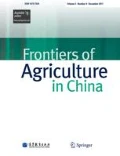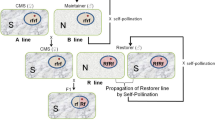Abstract
The phenotypic response of two soybean cultivars to a chemical mutagen (ethyl methane sulphonate, EMS), physical mutagen (gamma rays) and their combinations were studied in M1 and M2 generations and the frequency and spectrum of chlorophyll mutations were worked out. Combined treatment was found to be more effective in inducing chlorophyll mutations compared to individual treatments of gamma rays and EMS in both the cultivars. As far as the spectrum of chlorophyll mutations is concerned, a wider spectrum in both the cultivars was observed in 45 kR + 0.2% EMS combined treatment.
Similar content being viewed by others
References
Bhatia C, Swaminathan M S (1963). Frequency and spectrum of mutations induced by radiations in some varieties of bread wheat. Euphytica, 12: 97–112
Blixt S (1968). Studies on induced mutations in peas XXIV genetically conditioned differences in radiation sensitivity 2. Hereditas, 59: 303–328
Das P K, Kundagrami S (2000). Frequency and spectra of chlorophyll mutations in grasspea induced by gamma rays. Indian Journal of Genetics and Plant Breeding, 60(2): 239–241
Gaul H (1964). Mutations in plant breeding. Rad Bot, 13: 330–336
Geetha K, Vaidyanathan P (2000). Studies on induction of chlorophyll mutation in soybean through physical and chemical mutagens. Agricultural Science Digest, 20(1): 33–35
Goud J V (1967). Induced polygenic mutations in hexaploid wheat. Radiation Biology, 7: 321–331
Gregory W C (1965). Mutation frequency, magnitude of changes and the probability of improvement in adaptation: In the use of induced mutation in plant breeding. Rep FAO/I A E A, Tech Meet Rome, 429–441
Gustafsson A (1940). The mutation system of chlorophyll apparatus. Lund Univ Arsskr N E Avd, 2(36): 1–40
Harb R K H (1990). Frequency, spectrum, anatomical and chemical studies on soybean chlorophyll mutations. Bulletin Faculty Agric Univ Cario, 41(3): 595–608
Paul A, Singh D P (2002). Induced chlorophyll mutations in lentil (Lens culnaris Medik). Indian Journal Genet, 63(3): 263–264
Prasad A B, Das A K (1980). Studies in induced chlorophyll mutations in Lathyrus sativus L. Cytologia, 45: 335–341
Rajput M A, Sarwar G (1996). Radiation induced chlorophyll mutations in lentil. Lens-Newsletter, 23(1/2): 3–4
Solanki I S, Phogat D S (2005). Chlorophyll mutation induction and mutagenic effectiveness and efficiency in macrosperma lentil (Lens culnaris Medik). National Journal of Plant Improvement, 7(2): 81–85
Zareen F, Devi P (1995). Mutagenic effectiveness and efficiency of certain mutagens in Brassica compestris. Journal of Cytology and Genetics, 30(1): 7–12
Author information
Authors and Affiliations
Corresponding author
About this article
Cite this article
Khan, M.H., Tyagi, S.D. Studies on induction of chlorophyll mutations in soybean, Glycine max (L.) Merrill. Front. Agric. China 3, 253–258 (2009). https://doi.org/10.1007/s11703-009-0058-2
Received:
Accepted:
Published:
Issue Date:
DOI: https://doi.org/10.1007/s11703-009-0058-2




